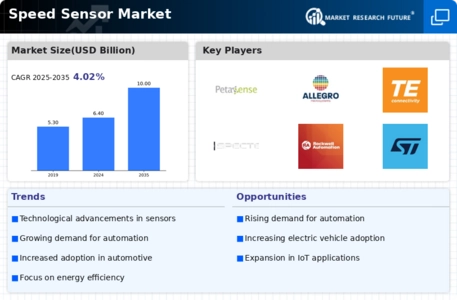Leading market players are investing heavily in research and development in order to expand their product lines, which will help the Speed Sensor market, grow even more. Market participants are also undertaking a variety of strategic activities to expand their global footprint, with important market developments including new product launches, contractual agreements, mergers and acquisitions, higher investments, and collaboration with other organizations. To expand and survive in a more competitive and rising market climate, Speed Sensor industry must offer cost-effective items.
Manufacturing locally to minimize operational costs is one of the key business tactics used by manufacturers in the global Speed Sensor industry to benefit clients and increase the market sector. In recent years, the Speed Sensor industry has offered some of the most significant advantages to medicine.
Major players in the Speed Sensor market, including SICK AG, Petasense, Allegro MicroSystems, Inc., Robert Bosch GmbH, NXP Semiconductors N.V., Infineon Technologies AG, Sensoronix, Inc., TE Connectivity, Inc., SPECTEC, Sensor Solutions Corporation, ABB, Rockwell Automation, Inc., STMicroelectronics, Pepperl+Fuchs, and Schneider Electric, are attempting to increase market demand by investing in research and development operations.
An engineering and technology corporation is Honeywell International Inc. The business develops and produces technology to address problems in a number of industries, including energy, security, safety, productivity, and global urbanisation. Specialty chemicals, process technologies, electrical and sophisticated materials, productivity, sensing, safety and security technology, and spare parts are just a few of the things Honeywell has to offer. Additionally, it offers management, technical, repair, and maintenance services. In North America, Europe, and other continents, Honeywell provides services to clients in the building, petrochemical, aircraft, and refining industries. Around the world, it has manufacturing and other operations.
Charlotte, North Carolina, in the US, serves as the headquarters for Honeywell. By using a magnetically biassed Hall-effect integrated circuit (IC), Honeywell's SNG-S Series Speed Sensors will be able to precisely detect the movement of ferrous metal targets by April 2022.
A provider of technology and services, Robert Bosch GmbH (Bosch) is a division of Robert Bosch Stiftung GmbH. The business provides a broad range of goods and services, including automotive components and accessories, e-bike systems, automotive technology, home appliances, security systems, solar inverters, packaging technology, industry solutions, and business process management solutions. The company serves clients in the automotive, consumer electronics, and BPO sectors in the Americas, Europe, Asia Pacific, and Africa along with sales and service partners, subsidiaries, and local businesses. The headquarters of Bosch are in Stuttgart, Germany.
Bosch's wheel speed sensor programme for the US automobile aftermarket was introduced in September 2017. This makes it possible to access a large variety of parts and helps cars adhere to rigorous original engine requirements.


















Leave a Comment